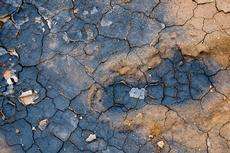Soil responsible for heat waves

Climate change will not just influence the average climate but also extremes such as heat waves, models from climate researchers indicate. Using broad measurements taken in southeastern Europe,a study demonstrates that the moisture contained in soils play an essential role for these extremes. Compared to wet summers, the frequency of very hot days increases tenfold in summers with dry soils.
Temperatures are rising, as measurements throughout Europe reveal. In particular, heat waves are longer, increasingly more intense and occurring more frequently in the eastern Mediterranean region.
A group of researchers led by Sonia Seneviratne from the Institute for Atmospheric and Climate Science at ETH Zurich and Martin Hirschi from MeteoSwiss have now succeeded in gathering sufficient data to investigate processes controlling extremes in Central and Eastern Europe. The evaluation of data measured at 275 weather stations in that region revealed that the summer hot extremes in southeastern Europe are actually more intense the stronger precipitation deficits in preceding months are, that is when the soil is drier.
In Central Europe, on the other hand, there is little correlation between measured precipitation deficits and temperature extremes. The climate regime, and thus the average soil moisture content, appears to be a key factor in the correlation between the amount of rainfall and extreme hot temperatures. “It acts as a control factor for the impact of the precipitation deficit on hot extremes”, explains Sonia Seneviratne. “The relationship between soil moisture and hot extremes is strongest in transitional zones between wet and dry climates.”
In Romania and Bulgaria the proportion of hot days increases from 4.5 to 43 percent for dry vs wet conditions, and the heatwave length correspondingly increases from 1.2 to 6.9 days. In Austria and the Czech Republic, however, there appears to be little correlation between the registered heatwaves and the dryness of the soils.
A lack of soil moisture thus leads to the intensification of hot extremes, but only in certain climate or soil-moisture zones. Existing climate models are only partly accurate because they register this effect in Romania and Bulgaria but overestimate it in central Europe. However, these conditions could be modified in decades to come as a result of climate change and an increasing soil dryness in this region.
The analysed measurements were taken at 275 meteorological stations in two different regions in Central and Eastern Europe: Romania and Bulgaria, where evaporation is often limited due to soil dryness; and Austria and the Czech Republic, which are characterized by a more humid climate, and thus where evaporation is not limited by the soil moisture, but rather by the available energy – solar radiation and air temperature. The data was analysed using so-called quantile regression – a method predominantly used in econometrics and ecology. It was recently used to examine sea level trends in the Baltic Sea.
The obtained results might help to improve predictions for hot extremes since soil moisture varies relatively slowly. In regions where the correlation between soil moisture and hot extremes is particularly pronounced, it would thus be possible to detect increased risks of summer hot extremes weeks and even months in advance. This would also be relevant for long-term adaptation, since the current values in southeastern Europe may well hold for central Europe by the end of the 21st century.
More information: Hirschi M, Seneviratne SI, Alexandrov V, Boberg F, Boroneant C, Christensen OB, Formayer H, Orlowsky B, Stepanek P. Observational evidence for soil-moisture impact on hot extremes in southeastern Europe. Nature Geoscience, 12 December 2010. doi:10.1038/ngeo1032
Provided by ETH Zurich
















